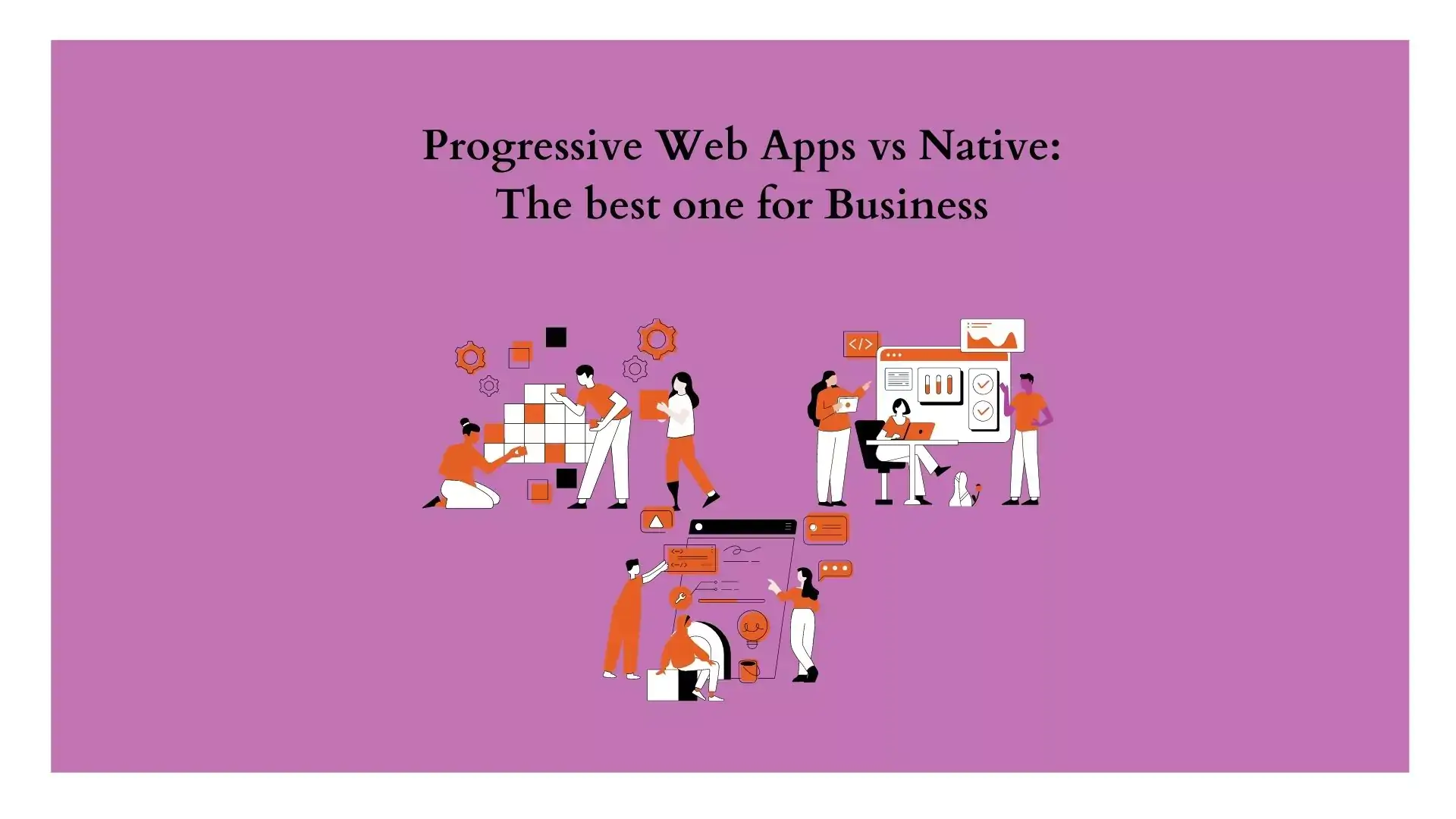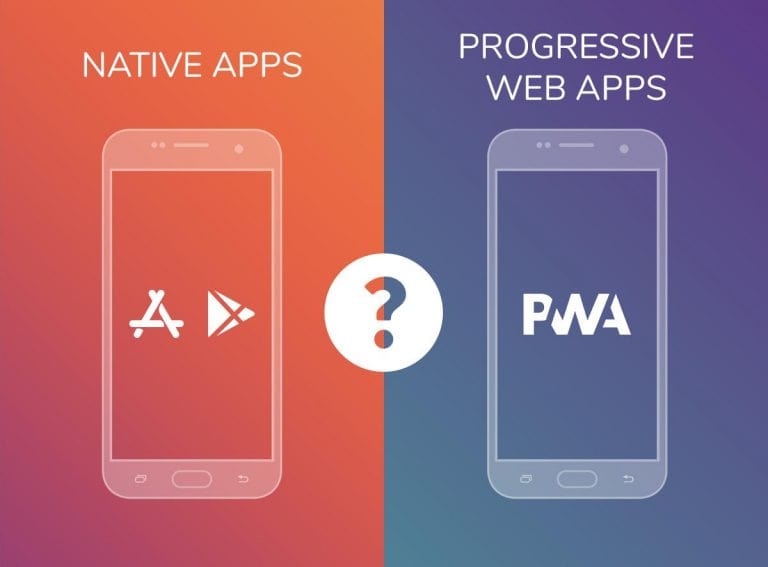
Businesses have to make many tough choices when it comes to what technology to use for their app. Do they go with a progressive web app, or do they go with a native app? Both options have pros and cons, but which one is the best for businesses?
In this blog, we’ll look at the differences between progressive web apps and native apps, and we’ll try to answer that question. We’ll also discuss the benefits of using progressive web apps over native apps. So if you’re curious about whether or not a progressive web app is right for your business, read on!
Before we give our opinions on the best solution to serve your customers or meet your goals for business, We’ll start by reviewing how Progressive Web App is.

Four of the key technologies in PWA
Progressive Web Apps are web-based applications that combine a website and a native app. Also, they are websites that emulate Native App behavior, thus giving users an experience similar to one. The experience and capabilities of the PWA are similar to native apps. It can also incorporate offline functionality, push notification, and many more.
With the help of a PWA, it is possible to use web-based technologies you are familiar with, including CSS, HTML, and JavaScript, which can turn virtually every website into an app that performs and looks like native apps. The users would be unable to distinguish between the two!
Did you realize that Twitter is, in fact, a PWA instead of an app that is native? If you access Twitter.com using a mobile device, you can download it on your home screen. Then, after you have opened the saved Twitter website, it will function as the native app. There will not even be any browser windows. Furthermore, it will operate the same way on Android and an iPhone.
In reality, any business could develop the PWA solution to extend its digital footprint and guarantee an enjoyable user experience. But, some businesses might think about developing a native app due to the benefits that the PWA does not offer. However, it’s up to your decision to choose which choice to make to meet your business objectives.
Let’s create a comparison table to give you a more clear view about progressive web apps vs native.
| PWA | Native Apps |
|
|
Benefits of Progressive Web App Development
In general, there are four well-known programming languages used by developers to build Native Apps:
- Swift or Objective-C for iOS
- Java or Kotlin for Android
There is an alternative. You can make use of cross-platform frameworks, such as React Native. We have used this development method for more than 9 years and are currently. It lets you create hybrid apps using JavaScript-like programming and then send the solutions on each Android and iOS platform in one step. React Native applications are extremely efficient and feel like native apps.
Benefits of Native App Development
Let’s now move to the essential Native Apps pros over PWAs.
- Performance enhancement and improved UI/UX
Since the code is designed to run on a specific device or OS, A Native App connects seamlessly to its ecosystem and has access to all APIs. It is faster and has more capabilities for UI/UX experience. In addition, Native Apps can smoothly communicate with other native apps provided by Google and Apple.
- Monetization privilege
In contrast to the PWA, which requires a customized payment processing service, Native Apps are monetizable through the built-in App Stores’ payments methods. Users can make purchases and purchase subscriptions easily.
- App Store Support
Although PWAs have SEO benefits, Native Apps have App Store Optimization (ASO) and Apple Search Ads (ASA) alternatives. These are cost-effective strategies (keyword research, attractive Meta descriptions, titles, other such things) that enable you to attract new users by increasing your position in the App Search results in the Store. Additionally, users can evaluate the app, which can be a traffic source (if your rating is favorable).
- Security
PWAs are secure as they are running under HTTPS. But, Native Apps have direct access to all of the devices’ hardware and software features. However, it’s simpler for developers to apply the most secure methods, such as two-factor authentication. In addition, Native Apps must comply with the requirements of various standards established by app stores before they can be accepted.
Cons of Native Apps
- Costly development
It is essential to have at least two developers develop an app from scratch for every platform. So, you can make sure you have Android, and iOS users will use your mobile application. Additionally, the final application requires regular maintenance and updates on two different OS. However, you can reduce your costs and speed up development by hiring React Native experts.
- Do you need time to launch?
As previously mentioned, Native Apps should be approved by Google’s Play Market or Apple’s App Store before users can download the apps. The process could last for an entire week or even longer. In certain instances, applications are rejected for various reasons, including copyright infringement, plagiarism, or plagiarism. Developing a PWA is much faster than the time-consuming native platforms if you are working with a strict time-to-market date.
- Very difficult to market
Native apps aren’t indexed or included in the search engines, so you’ll likely need to contact third-party advertising companies or purchase promo campaigns on the most popular websites to market your application.
- Installation routine
The users don’t appreciate it when they have to search or download. Particularly when they have to buy something or look at a catalog, as an instance, this factor is why they prefer to utilize a website or PWA instead.
What is the best option: PWA or Native App?
With the many advantages of the two Native Apps and PWAs, it’s important to consider every aspect and decide on the best route based on your current business plan and available resources. As you will see, PWAs and native Apps are equally essential for all businesses of any type and size, regardless of whether they be startups, growing companies, or large enterprises.
There may be a need for an efficient and quick solution in certain situations, and choosing a PWA is recommended. On the other hand, the PWA could not offer an adequate performance level or cover all of the device’s capabilities. If this is the situation, you could construct a Native App. If not, you could create apps using PWA to improve your customer experience and reach a larger market.
When should you build a PWA?
- A feature-rich app is important, and you want to develop an easy app for your customers.
- You are looking to create an application that uses the latest features on smartphones. You’re working with a limited budget and have a deadline (faster TTM)
- The app you’re developing requires integration with other apps. You haven’t thought of the perfect business concept, and you’re looking to build an MVP first.
- You require a mobile-friendly solution that is backed by solid security algorithms. The app’s features or content could not be compatible with the App Store’s guidelines.
- You’d like to establish a trustworthy image and boost its credibility. It’s not a great idea to have dependent push notifications from iOS users.
Conclusion
It is up to the business owners to decide which platform best fits your product. Both platforms have pros and cons, but they all do what they say on the tin at the end of the day – providing an awesome experience for users. If this article has given you some thought or ideas about using progressive web apps more in your marketing strategy, then we have done our job well! Contact us for a free consultation on what development would best fit your product. We would love to hear from you!

Dr.Supreena has published two international books in finance with the able guidance of her guide and department at Ethiraj College of Women, University of Madras during her PhD in Economics and Finance. She is the Recipient of Dr Vedagiri Shanmugasundaram (An Oxford Scholar) Award for Outstanding and Successful PhD Candidate from Ethiraj College for Women concerning research record and academic distinction. She is experienced in the domain of finance, digital marketing and information technology writing on Artificial Intelligence, IoT, PaaS and SaaS cloud computing etc. She is NIIT qualified in Advanced Network Computing, Google Certified in digital marketing. Her hobbies to maintain balance and reduce stress are gardening and cooking.

